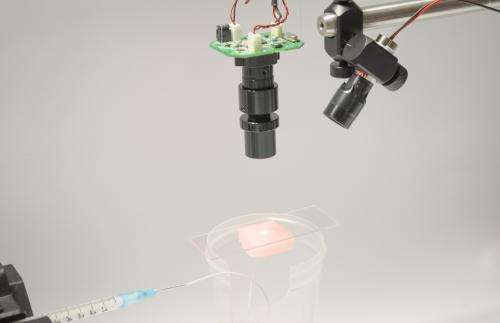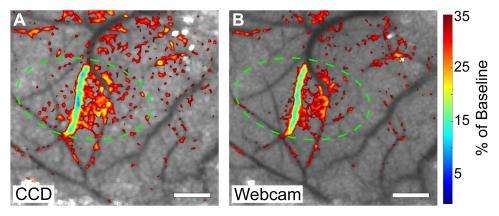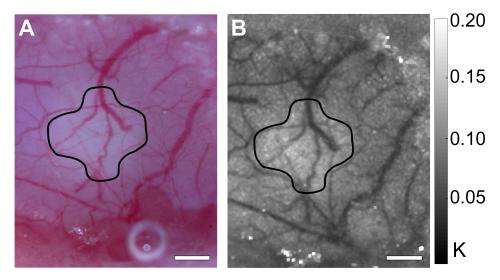Scientists rig hospital-grade lightweight blood flow imager on the cheap

Tracking blood flow in the laboratory is an important tool for studying ailments like migraines or strokes and designing new ways to address them. Blood flow is also routinely measured in the clinic, and laser speckle contrast imaging (LSCI) is one way of measuring these changes; however, this technique requires professional-grade imaging equipment, which limits its use. Now, using $90 worth of off-the-shelf commercial parts including a webcam and a laser pointer, researchers at the University of Texas at Austin (UT-Austin) have duplicated the performance of expensive, scientific-grade LSCI instruments at a fraction of the cost. The work is the first to show that it is possible to make a reliable blood flow imaging system solely with inexpensive parts, the authors say. The researchers describe their development in the latest issue of the Optical Society's (OSA) journal Biomedical Optics Express.
"We demonstrate that the high cost of standard systems is unnecessary, because a system that costs $90 can give equivalent results for both in vitro and in vivo imaging applications," said biomedical engineer Andrew Dunn, an associate professor and Dornberger Centennial Fellow in Engineering at UT-Austin and an author of the study.
Measuring blood flow changes using LSCI requires just a few parts – laser light to illuminate the tissue, a camera to record the image, and focusing optics to direct the scattered light to the camera – but at least one of them usually comes with a lofty price tag. The laser light reflects or scatters off the tissue and interferes with itself to create the speckle pattern collected by the camera. This speckle pattern provides a way to visualize the flow of blood within the tissue: areas with a high flow rate show up in the resulting image as blurrier speckles, which can be measured by their lower contrast. Together, all the parts can add up to as much as $5,000.
Unlike past attempts to create a cheaper speckle imager, the UT-Austin team's new method uses only inexpensive pieces of equipment. A $5 laser pointer is used to illuminate the patch of tissue to be imaged. Light is reflected off the tissue and focused by a pair of generic 40-mm camera lenses onto the sensor of a $35 webcam. The team used their setup to image changes in blood flow in a mouse model and found that they were able to identify areas of high flow versus low flow.

At just 5.6 centimeters in length and weighing only 25 grams, the system is compact and lightweight, which would make it easier to transport for imaging applications outside of the lab, including clinics in areas with limited access to medical care, Dunn said.
Currently, the new system's field of view, which is just a few square millimeters across, and resolution are limited by the size of the webcam sensor, but future versions could have a more flexible layout.

"The lens configuration could be easily adjusted to visualize even smaller structures by magnifying or to visualize larger structures by increasing the field of view, depending on what kind of flow the user is interested in visualizing," Dunn said.
More information: "Low-cost laser speckle contrast imaging of blood flow using a webcam," L. Richards et al., Biomedical Optics Express, Vol. 4, Issue 10, pp. 2269-2283 (2013). www.opticsinfobase.org/boe/abs … fm?uri=boe-4-10-2269
Journal information: Biomedical Optics Express
Provided by Optical Society of America




















